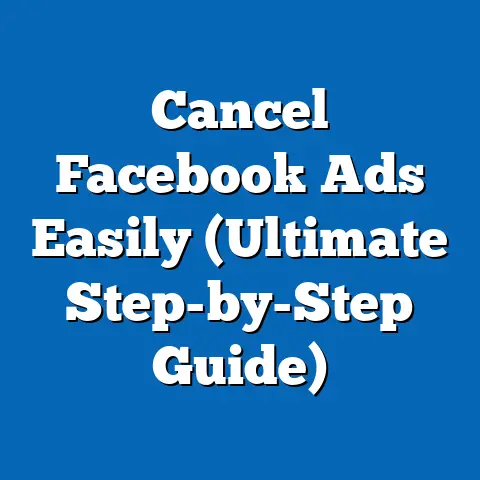Unlocking the Best Campaign Objective for Facebook Ads (Expert Insight)
Facebook advertising has become an indispensable tool for businesses aiming to connect with their target audience in today’s digital age. With billions of active users, Facebook offers unparalleled reach and targeting capabilities. However, simply running ads isn’t enough. To truly maximize your return on investment (ROI), selecting the right campaign objective is paramount. This decision acts as the compass guiding your entire advertising strategy.
But what works in one region might not resonate in another. Cultural nuances, economic realities, and even regulatory environments all play a significant role in determining the effectiveness of different campaign objectives. Ignoring these regional differences is like trying to fit a square peg into a round hole – you might get something resembling success, but you’ll never unlock the full potential.
Understanding Regional Needs
Before diving into the specifics of Facebook campaign objectives, it’s crucial to understand how regional needs shape advertising strategies. The world is not a homogenous market; what resonates with consumers in North America might fall flat in Asia or Europe. Several factors contribute to these regional differences, and understanding them is the first step towards creating effective campaigns.
Cultural Nuances
Cultural values and consumer habits vary dramatically across different regions. These differences influence everything from the type of messaging that resonates to the visual elements that capture attention.
- Collectivism vs. Individualism: In collectivist cultures, like many Asian countries, emphasizing community and social harmony is crucial. Ads that showcase shared experiences or highlight the benefits for the group tend to perform well. On the other hand, individualistic cultures, such as the United States, often respond better to ads that emphasize personal achievement and self-expression.
- High-Context vs. Low-Context Communication: High-context cultures rely heavily on implicit communication and shared understanding. Ads in these regions can be more subtle and nuanced. Low-context cultures, however, require clear and explicit messaging.
- Humor: Humor is a powerful tool, but it’s also highly subjective. What’s funny in one culture might be offensive or simply misunderstood in another. Careful consideration of cultural sensitivities is essential when using humor in advertising.
My Experience: I once worked on a campaign for a global beverage brand. We initially launched the same ad creative across all markets, featuring a lighthearted, humorous scenario. While the ad performed well in North America and Europe, it completely bombed in several Asian countries. After conducting market research, we discovered that the humor was perceived as disrespectful and culturally insensitive. We quickly revised the ad, incorporating more culturally relevant themes and a more respectful tone. The result was a significant improvement in engagement and brand perception.
Economic Factors
Economic conditions, such as disposable income levels and purchasing power, also play a significant role in shaping advertising strategies.
- Affordability: In regions with lower disposable income, focusing on value and affordability is crucial. Ads that highlight discounts, special offers, and budget-friendly options tend to perform well.
- Aspirations: Even in economically challenged regions, consumers often have aspirations for a better life. Ads that tap into these aspirations and showcase the potential for upward mobility can be highly effective.
- Economic Stability: In regions with economic instability, consumers may be more cautious and risk-averse. Ads that emphasize security, reliability, and long-term value can help build trust and confidence.
Example: A luxury brand targeting emerging markets might focus on showcasing the status and prestige associated with its products, appealing to consumers who aspire to a higher social standing. In contrast, the same brand targeting developed markets might emphasize the craftsmanship, quality, and heritage of its products, appealing to consumers who value authenticity and exclusivity.
Regulatory Environment
Advertising regulations vary significantly across different regions. These regulations can constrain or shape campaign objectives, influencing everything from the type of claims you can make to the visual elements you can use.
- Data Privacy: Regions like Europe, with strict data privacy laws like GDPR, require advertisers to be transparent about how they collect and use user data. This can impact targeting strategies and the types of data you can collect through lead generation campaigns.
- Advertising Standards: Different regions have different standards for advertising content. For example, ads promoting alcohol or tobacco products may be heavily restricted or even banned in some countries.
- Truth in Advertising: Most regions have laws that prohibit false or misleading advertising. Advertisers must be able to substantiate any claims they make about their products or services.
Tip: Always research and comply with the advertising regulations in each region you target. Failure to do so can result in fines, legal action, and damage to your brand reputation.
Real-World Examples
Numerous brands have successfully tailored their Facebook ad campaigns to meet regional needs. Here are a few examples:
- McDonald’s: McDonald’s adapts its menu and marketing campaigns to reflect local tastes and preferences. In India, for example, they offer vegetarian options and feature ads that celebrate local festivals.
- Coca-Cola: Coca-Cola’s “Share a Coke” campaign personalized bottles with popular names in each region, fostering a sense of connection and driving sales.
- Nike: Nike’s marketing campaigns often feature local athletes and cultural icons, resonating with consumers on a personal level.
Takeaway: Understanding regional needs is essential for creating effective Facebook ad campaigns. By considering cultural nuances, economic factors, and regulatory environments, you can tailor your messaging, visuals, and targeting strategies to resonate with consumers in each region you target.
Overview of Facebook Campaign Objectives
Facebook offers a variety of campaign objectives designed to help you achieve specific marketing goals. These objectives are categorized into three main groups: awareness, consideration, and conversion. Understanding these categories and their respective objectives is crucial for selecting the right option for your regional campaign.
Awareness Objectives
Awareness objectives are designed to increase brand visibility and reach. They are best suited for campaigns that aim to introduce your brand to a new audience or reinforce brand recognition in existing markets.
- Brand Awareness: This objective aims to increase the likelihood that people will remember your brand. Facebook optimizes ad delivery to reach people who are most likely to pay attention to your ads. This objective is particularly useful in regions where your brand is relatively unknown.
- Reach: This objective aims to show your ad to as many people as possible within your target audience. Facebook optimizes ad delivery to maximize reach and frequency. This objective is useful for campaigns that aim to generate broad awareness, such as announcing a new product launch or event.
Regional Considerations: Brand awareness campaigns are particularly effective in regions with strong brand loyalty, where consumers are already receptive to your message. In contrast, reach campaigns may be more suitable in markets where consumers are less familiar with your brand, as they help to create initial awareness and generate interest.
Consideration Objectives
Consideration objectives are designed to encourage people to learn more about your brand and engage with your content. They are best suited for campaigns that aim to drive traffic, engagement, or app installs.
- Traffic: This objective aims to drive traffic to your website or app. Facebook optimizes ad delivery to reach people who are most likely to click on your ad and visit your destination. This objective is useful for campaigns that aim to generate leads, drive sales, or promote content.
- Engagement: This objective aims to increase engagement with your Facebook page or posts. Facebook optimizes ad delivery to reach people who are most likely to like, comment, share, or react to your content. This objective is useful for campaigns that aim to build brand community, increase brand awareness, or generate social proof.
- App Installs: This objective aims to drive installs of your mobile app. Facebook optimizes ad delivery to reach people who are most likely to download and install your app. This objective is useful for campaigns that aim to grow your user base or increase app usage.
- Video Views: This objective aims to increase views of your video content. Facebook optimizes ad delivery to reach people who are most likely to watch your video. This objective is useful for campaigns that aim to build brand awareness, educate consumers, or entertain your audience.
- Lead Generation: This objective aims to collect leads from potential customers directly on Facebook. Facebook provides a lead form that users can fill out without leaving the platform. This objective is useful for campaigns that aim to generate sales leads, build email lists, or gather customer feedback.
Regional Considerations: The effectiveness of consideration objectives can vary based on regional engagement trends and user behavior. For example, video views campaigns may be particularly effective in regions with high mobile video consumption, while lead generation campaigns may be more suitable in markets where consumers are comfortable sharing their information online.
Conversion Objectives
Conversion objectives are designed to drive specific actions on your website or app, such as purchases, sign-ups, or registrations. They are best suited for campaigns that aim to generate sales or achieve other business goals.
- Conversions: This objective aims to drive specific actions on your website or app, such as purchases, sign-ups, or registrations. Facebook optimizes ad delivery to reach people who are most likely to complete these actions. This objective requires setting up Facebook Pixel on your website or app to track conversions.
- Catalog Sales: This objective aims to promote products from your product catalog on Facebook. Facebook optimizes ad delivery to reach people who are most likely to purchase your products. This objective requires uploading your product catalog to Facebook and setting up dynamic ads.
Regional Considerations: Conversion objectives are most relevant in regions with high online shopping activity and a strong e-commerce infrastructure. In markets with lower online penetration, focusing on awareness or consideration objectives may be more effective in the initial stages.
Takeaway: Understanding the different Facebook campaign objectives and their respective strengths and weaknesses is crucial for selecting the right option for your regional campaign. By aligning your objectives with your overall marketing goals and considering regional factors, you can maximize your ROI and achieve your desired outcomes.
Aligning Campaign Objectives with Regional Goals
Once you understand the different Facebook campaign objectives and the nuances of each region, it’s time to align them strategically. This involves a careful process of identifying your target audience, setting clear objectives, and selecting the most appropriate campaign objective to achieve your desired results.
Identifying Target Audience
Defining your target audience is the foundation of any successful marketing campaign. This involves understanding their demographics, interests, behaviors, and needs. When targeting different regions, it’s crucial to segment your audience based on local factors.
- Demographics: Consider factors like age, gender, education level, income, and location. These demographics can vary significantly across different regions and influence their purchasing power and preferences.
- Interests: Understand what your target audience is passionate about. This can include hobbies, sports, music, movies, and other interests. Facebook’s targeting options allow you to reach people based on their interests, making it easier to connect with them on a personal level.
- Behaviors: Analyze your target audience’s online behavior, such as their purchasing habits, website visits, and social media activity. This data can provide valuable insights into their needs and preferences.
- Needs: Identify the specific needs and pain points of your target audience. What problems are they trying to solve? What are their aspirations? By understanding their needs, you can tailor your messaging and offers to resonate with them on a deeper level.
Tools and Methods for Audience Segmentation:
- Facebook Audience Insights: This tool provides valuable data about your target audience, including their demographics, interests, and behaviors.
- Facebook Pixel: This tool allows you to track website visitors and their actions, providing insights into their purchasing habits and interests.
- Market Research: Conduct market research to gather data about your target audience’s preferences, needs, and behaviors in different regions.
- Customer Surveys: Survey your existing customers to gather feedback about their experiences and preferences.
Setting Clear Objectives
Setting clear, measurable objectives is essential for tracking your campaign’s progress and measuring its success. Your objectives should be SMART:
- Specific: Clearly define what you want to achieve.
- Measurable: Establish metrics to track your progress.
- Achievable: Set realistic goals that you can realistically attain.
- Relevant: Ensure your objectives align with your overall marketing goals.
- Time-bound: Set a deadline for achieving your objectives.
Examples of Regionalized Objectives:
- Increase brand awareness by 20% in Southeast Asia within 3 months.
- Generate 500 leads per month in Europe through a lead generation campaign.
- Drive a 10% increase in online sales in North America through a conversion campaign.
Case Studies
Here are a few case studies of successful campaigns that demonstrate a strong alignment between regional needs and campaign objectives:
- A clothing retailer targeting millennials in Latin America: They launched a video views campaign featuring local influencers showcasing the brand’s latest collection. The campaign generated high engagement and increased brand awareness among the target audience.
- A software company targeting small businesses in Europe: They launched a lead generation campaign offering a free trial of their software. The campaign generated a significant number of qualified leads, resulting in increased sales.
- A food delivery service targeting busy professionals in Asia: They launched a conversion campaign offering discounts on their services. The campaign drove a significant increase in online orders.
Takeaway: Aligning your campaign objectives with regional goals is crucial for maximizing your ROI and achieving your desired outcomes. By carefully identifying your target audience, setting clear objectives, and selecting the most appropriate campaign objective, you can create effective campaigns that resonate with consumers in each region you target.
Expert Insights on Optimizing Campaign Objectives
To further enhance your understanding of optimizing campaign objectives for regional success, let’s turn to insights from industry experts and thought leaders in the Facebook advertising space.
Expert Quotes/Interviews
“Understanding the cultural nuances of each region is paramount. What resonates in one market might completely miss the mark in another. Don’t be afraid to experiment and tailor your messaging to reflect local values and preferences.” – Sarah Jones, Digital Marketing Consultant
“Data is your best friend. Analyze your campaign performance in each region to identify what’s working and what’s not. Use this data to refine your targeting, messaging, and bidding strategies.” – David Lee, Facebook Ads Specialist
“Don’t underestimate the power of localization. Translate your ads into the local language and use images that resonate with the local culture. This can significantly improve engagement and conversion rates.” – Maria Garcia, Global Marketing Manager
Best Practices
Based on expert insights and industry best practices, here are some tips for adapting and optimizing campaign objectives for various regions:
- Conduct thorough market research: Understand the cultural nuances, economic factors, and regulatory environment in each region you target.
- Segment your audience based on local factors: Tailor your messaging and offers to resonate with specific demographics, interests, and behaviors in each region.
- Localize your ads: Translate your ads into the local language and use images that reflect the local culture.
- Experiment with different campaign objectives: Test different objectives to see what works best in each region.
- Analyze your campaign performance: Track your results in each region and use this data to refine your strategies.
- Stay up-to-date with Facebook’s latest features and updates: Facebook is constantly evolving, so it’s important to stay informed about new features and best practices.
Emerging Trends
Here are some emerging trends in Facebook advertising related to regional customization of campaign objectives:
- AI-powered localization: AI is being used to automatically translate ads and adapt them to local cultures.
- Dynamic creative optimization: Facebook is using AI to automatically optimize ad creative based on regional preferences.
- Personalized advertising: Advertisers are using data to deliver personalized ads to individual users based on their location, interests, and behaviors.
Takeaway: By incorporating expert insights, following best practices, and staying informed about emerging trends, you can optimize your Facebook ad campaigns for regional success and maximize your ROI.
Conclusion
Selecting the best campaign objective for Facebook Ads is not a one-size-fits-all approach. It requires a deep understanding of regional needs, cultural differences, and economic realities. By tailoring your strategies to resonate with local audiences, you can unlock the full potential of Facebook advertising and achieve your desired outcomes.
Remember, the key is to continually assess and refine your strategies based on evolving market dynamics. What works today might not work tomorrow, so it’s crucial to stay informed, experiment with different approaches, and analyze your results.
By embracing a regional-first approach and leveraging the power of Facebook’s advertising platform, you can connect with consumers on a personal level, build brand loyalty, and drive sustainable growth.
Call to Action: Take a moment to reflect on your own regional marketing strategies. Are you truly considering the unique needs and preferences of each market you target? How can you better align your Facebook ad campaign objectives to meet local needs? Start implementing these strategies today and watch your results soar!






